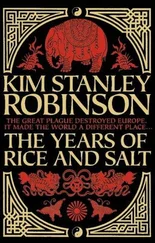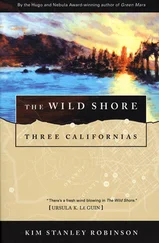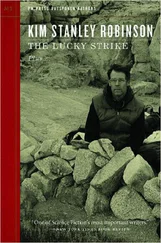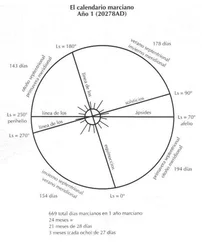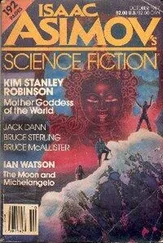Chapter 23
Enough Is As Good As a Feast
We built our house on the apron of Jones Crater, latitude 19 degrees south, longitude 20 degrees. The apron was pretty well populated, some two thousand farms like ours scattered around it, but we could not see any other homesteads from ours, even though we built most of it on the top of a broad-backed low ridge raying down the southwest flank of the crater. We could see the vineyards of the Namibians’ village to the north of us, and the tops of the line of cypresses that bordered their pond. And down the apron the bare rock in our prospect was patched with light green squares, marking young orchards like ours.
Craters turned out to be one of the places that people homed in on when they moved out into the backcountry, especially in the southern highlands. For one thing there were a million of them, so it was easy to find empty ones. At first people sheltered inside them, in the early years often doming the craters over and establishing little central crater lakes. By the time the ambient air had become livable, people had learned that settling inside a crater is like moving into a hole. Short days, no view, problems with flooding, and so on. So the new open-air settlements moved out over the rims onto the aprons, to have a look around. The interiors became full crater lakes, or lakes and rice terraces, depending on their climate, water allotment, pan integrity, and the like. Meanwhile the aprons were developed into crops, orchards, and pasturage, wherever there were the right conditions for soil creation. Fissures raying down the aprons served as the streambeds for rapid tumultuous creeks, the water pumped to their tops, or drawn down from rim water tanks that were pump-filled. Irrigation systems were always elaborate. Meanwhile the rims themselves tended to turn into the downtowns, as they had the longest views, and access both back in to the old towns in the crater interiors, and out to the many new settlements stretching down the apron. Rim roads called High Street became common, with fully developed urbanization all the way around. For small craters, the thousands that are around one kilometer in diameter, the densely populated rim was like a large village, very homey and comfortable; everyone known by sight, that kind of thing. Perhaps a thousand people; then the apron would typically have a population of half that, or less. With bigger craters the rim towns got bigger, of course, and a town of fifty thousand people on the rim of a ten-kilometer crater was a common sight, something like the hilltop city-states of the Italian Renaissance, or American Midwestern college towns, in their characters—and there were hundreds of them. Some prospered and became bustling little cities, spilling down into their interiors, which were like central parks, with round lakes or sculptured wetlands. The aprons almost always stayed agricultural, often supplying most of the food for the city up top. All these aspects of crater culture grew up spontaneously as the pattern language of the landscape, so to speak, combined with the emerging co-op culture, and, most simply, the needs of the people in the region being met in a rational way. Of course there was some planning. People would arrive at an unoccupied crater (among the some twenty thousand still listed by the environmental court for the southern highlands alone) with permits and programs, and set to work, and the first decade’s economic activity in the town was primarily the building of it, often by people who had an idea what they wanted; sometimes with people holding tattered copies of A Pattern Language or some other design primer in their hands, or surfing the Web for things they liked. But soon enough every crater had people moving in who were out of the original group’s control, and then it was a matter of spontaneous group self-organization, a process which works extremely well when the group is socially healthy.
Jones Crater was a big one, fifty kilometers in diameter, and its rim town was a beautiful new thing of transparent mushroom buildings and water tanks, and stone-faced skyscrapers clustered at the four points of the compass. Most of our farm group had been working up in town for some time, and eventually twenty families working on various ag projects decided to try moving downslope together, establishing a homestead and entering it into one of the ag travel loops. So we asked the regional environmental court for tenant rights to unclaimed land on the ray ridge, some forty kilometers down the south-south-west slope of the rim, and when we got the stewardship permits we moved on down and lived in tents that first winter. We had nothing, really, but the tents were big house tents from an earlier era, for the most part transparent and very pleasant to live in, as we could see so much of the world and its weather. So even though we were short on many things, that winter was so nice that we decided to build diskhouses as our permanent structures, so that we would continue to “live outdoors when indoors.”
These diskhouses were based on a design by a Paul Sattelmeier, from Minnesota. They were very simple, functional, and open places to live in, and easy to build. We got on the list for a mobile mold, and when it rolled by we punched in the commands and watched it throw big pottery: round roofs and slightly larger round floors, and then the walls, which were all interior straight segments; in effect the roof rested on a kind of double M made of interior walls, located under one semicircle of the roof only; the other side was the living room, a kind of big semicircular verandah, the roof freestanding over it. The several short walls extended from the central cross-wall into the other half of the house, dividing that semicircle into three bedrooms, two interior bathrooms, and part of a kitchen. The living rooms we faced downslope to give us the long view to the southwest, and the exterior circular “wall” on that side was only a clear tenting drape, which could be left open, which is what we did most of the time, living out in the wind; or else closed if it was cold or rainy. Same with the bedrooms on the upslope side, except their drape walls were white or colored or polarized to make them opaque. But those too were usually left open.
So we threw the parts for sixteen of these diskhouses, and then put them together. If you’re willing to do the labor the whole operation is not that expensive, although admittedly we were in hock to our town co-op right to the ears. For the most part the assembly of the diskhouses was straightforward, indeed a great pleasure. Some parts just grew into place after we set the right cultures to work: Our toilets and sinks and bathtubs and tile floors, for instance, were all bioceramic and grew right into their places, essentially as a kind of templated coral. Really lovely to see.
Long before we had even started on the houses, however, we were out laying soil and planting our orchards and vineyards. We grew as much of our own food as we could in truck gardens around the tents, using complete soils trucked in, but our money crop, our contribution to the Jones economy, was to be almonds and wine grapes, both proven growers on that flank of the apron. The wines being made up to that point had a volcanic tang to them that I didn’t like, almost a sulfur touch, but that was okay; it left room for improvement. And the almonds were great. We prepped soil and planted three hundred hectares of almonds and five hundred of wine grapes, in broad terraces concentric to the rim far above us, the ag zones broken by ponds and swamps, and all of them widening as they dropped downslope, so that they made a kind of giant quilt, pendant on our little farm which lay at the top of the land in our care. It was our work of art, and we were very devoted to it. I imagine we were like first-generation kibbutzim in many respects. About twenty couples, four of them same-sex; eleven single adults; thirty-odd kids, later fifty-three. Lots of travel by all of us on the local cog rail line up to Jones, and also laterally to other farms on the apron, to socialize and see what other people were doing agriculturally, and in their settlement design. They were all artists too.
Читать дальше
Конец ознакомительного отрывка
Купить книгу


